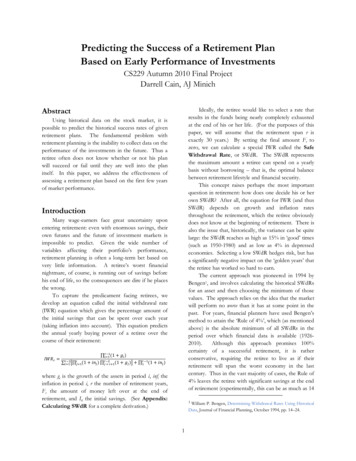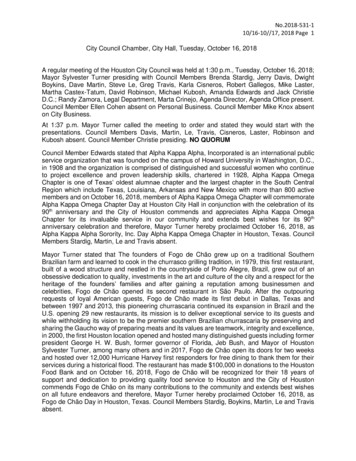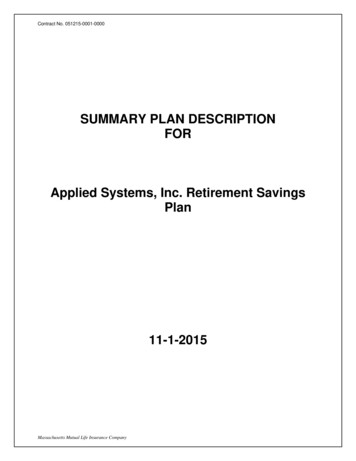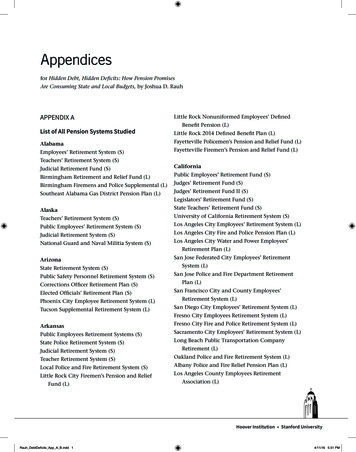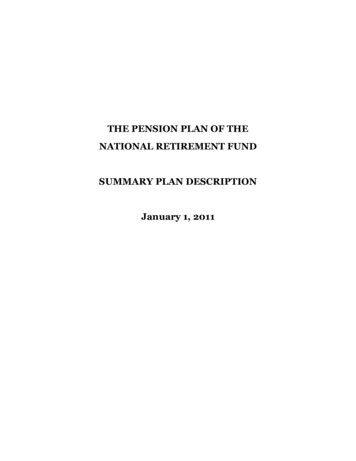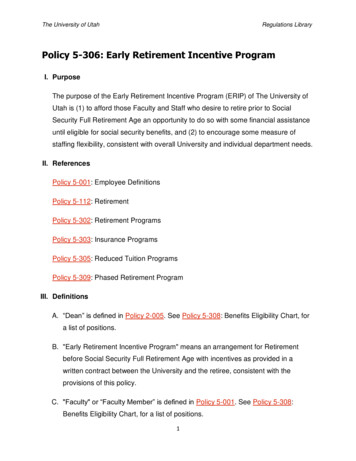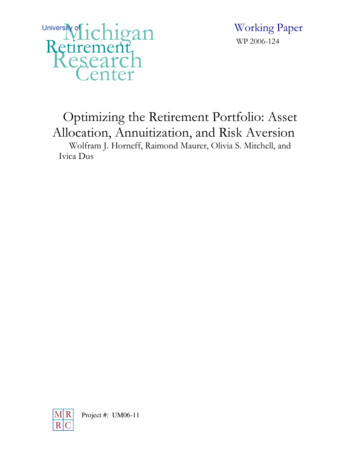
Transcription
MichiganRetirementResearchUniversity ofWorking PaperWP 2006-124CenterOptimizing the Retirement Portfolio: AssetAllocation, Annuitization, and Risk AversionWolfram J. Horneff, Raimond Maurer, Olivia S. Mitchell, andIvica DusMRRCProject #: UM06-11
“Optimizing the Retirement Portfolio: Asset Allocation,Annuitization, and Risk Aversion”Wolfram J. HorneffJohann Wolfgang Goethe—University of FrankfortRaimond MaurerJohann Wolfgang Goethe—University of FrankfortOlivia S. MitchellWharton School, University of PennsylvaniaIvica DusJohann Wolfgang Goethe—University of FrankfortJuly 2006Michigan Retirement Research CenterUniversity of MichiganP.O. Box 1248Ann Arbor, MI 48104http://www.mrrc.isr.umich.edu/(734) 615-0422AcknowledgementsThis work was supported by a grant from the Social Security Administration through theMichigan Retirement Research Center (Grant # 10-P-98358-5). The findings andconclusions expressed are solely those of the author and do not represent the views of theSocial Security Administration, any agency of the Federal government, or the MichiganRetirement Research Center.Regents of the University of MichiganDavid A. Brandon, Ann Arbor; Laurence B. Deitch, Bingham Farms; Olivia P. Maynard, Goodrich;Rebecca McGowan, Ann Arbor; Andrea Fischer Newman, Ann Arbor; Andrew C. Richner, Grosse PointePark; S. Martin Taylor, Gross Pointe Farms; Katherine E. White, Ann Arbor; Mary Sue Coleman, exofficio
Optimizing the Retirement Portfolio: Asset Allocation,Annuitization, and Risk AversionWolfram J. Horneff, Raimond Maurer, Olivia S. Mitchell, Ivica DusAbstractRetirees must draw down their accumulated assets in an orderly fashion so as not to exhausttheir funds too soon. We derive the optimal retirement portfolio from a menu that includespayout annuities as well as an investment allocation and a withdrawal strategy, assuming riskaversion, stochastic capital markets, and uncertain lifetimes. The resulting portfolioallocation, when fixed as of retirement, is then compared to phased withdrawal strategiessuch a “self-annuitization” plan or the 401(k) “default” pattern encouraged under US tax law.Surprisingly, the fixed percentage approach proves appealing for retirees across a wide rangeof risk preferences, supporting financial planning advisors who often recommend this rule.We then permit the retiree to switch to an annuity later, which gives her the chance to investin the capital market and “bet on death.” As risk aversion rises, annuities first crowd outbonds in retiree portfolios; at higher risk aversion still, annuities replace equities in theportfolio. Making annuitization compulsory can also lead to substantial utility losses for lessrisk-averse investors.Authors’ AcknowledgementsThis research was conducted with support from the Social Security Administration via the Michigan RetirementResearch Center at the University of Michigan under subcontract to the Johann Wolfgang Goethe-University ofFrankfurt and a TIAA-CREF Institute grant to the National Bureau of Economic Research. Additional supportwas provided by the Pension Research Council at The Wharton School of the University of Pennsylvania, andthe Fritz-Thyssen Foundation. Opinions and errors are solely those of the authors and not of the institutions withwhom the authors are affiliated. This is part of the NBER Program on the Economics of Aging. 2006 Horneff,Maurer, Mitchell, and Dus. All Rights Reserved.
Optimizing the Retirement Portfolio:Asset Allocation, Annuitization, and Risk AversionBaby Boomers nearing retirement are now targeted by competing financial serviceproviders seeking to help them manage their money in their golden years. Employer-basedpensions are also switching from defined benefit to defined contribution plans, furtherunderscoring retirees’ need for insights regarding how they might convert their accumulatedassets into a stream of retirement income without exhausting their funds too soon. On the onehand, insurers offer life annuities as the preferred distribution mechanism. On the other, mutualfund providers propose phased withdrawal plans as the better alternative. This paper comparesdifferent retirement payout approaches to show how people can optimize their retirementportfolios by simultaneously using investment-linked retirement rules along with life annuities.To explore this issue, we first evaluate payout products using the “default” patternadopted under US tax law for defined contribution or 401(k)-type pension portfolios. Thispermits us to determine whether these withdrawal rules suit a broad range of investors, and weillustrate the drawback of standardizing withdrawal rules. Next, we show that retirementplanning would not involve a simple choice between annuitizing all one’s money versusselecting a phased withdrawal plan, but rather it requires a combined portfolio consisting of bothannuities and mutual fund investments. Using a lifetime utility framework, we compare the valueof purchasing a stand-alone life annuity versus a phased withdrawal strategy backed by aproperly diversified investment portfolio, as well as combinations of these two products. Thisframework also enables us to demonstrate the welfare implications of making annuitizationcompulsory at a specific age, as is currently the case in Germany and the UK.Prior StudiesThe simplest form of life annuity is a bond-like investment with longevity insuranceprotecting the retiree from outliving her resources, guaranteeing lifetime level payments to theannuitant.1 Insurers hedge these contracts by pooling the longevity risks across a group ofannuity purchasers. Standard economic theory teaches us that life annuities will be valued byrisk-averse retirees, inasmuch as these contracts provide a steady income for life and hence they1Accordingly, life annuities are similar to public defined benefit pensions with respect to their payout structure.
2protect the retiree against the risk of exhausting her assets.2 Thus Yaari (1965) showed that theretiree maximizing a time separable utility function without a bequest motive would buyannuities with all her wealth, given a single risk-free asset and facing actuarially fair annuities;the approach has been extended by Davidoff et al. (2005) who again predicts full annuitization.Yet available evidence from most countries indicates that very few retirees actually purchaseannuities with their disposable wealth.Efforts to explain this so-called “annuity puzzle” have noted some disadvantages ofannuitization; for example, buyers lose liquidity because the assets usually cannot be recoveredeven to meet special needs (e.g. in the case of poor health; c.f. Brugiavini 1993). The presence ofa bequest motive also reduces retiree desires to annuitize wealth, and in the US, more than halfof the elderly anticipate leaving a bequest worth more than 10,000 (Bernheim, 2001; Hurd andSmith, 1999). Other explanations for why people may be reluctant to buy annuities include highinsurance company loadings; the ability to pool longevity risk within families; asymmetricmortality expectations between annuity buyers and sellers; and the existence of other annuitizedresources (e.g. Social Security or employer-sponsored pensions; c.f. Brown and Poterba, 2000;Mitchell et al., 1999). In addition, annuities appear relatively expensive in a low interest rateenvironment, as compared to equity-based mutual fund investments. And it also must be notedthat, in the US at least, many payout annuities sold by commercial insurers are fixed in nominalterms, so the annuity purchaser does not participate in stock market performance (c.f. Davidoff etal., 2005).Another reason people may not annuitize is that they believe they will do better bycontinuing to invest their retirement assets, making withdrawals periodically over theirremaining lifetimes. Doing this is not so simple, however, as the retiree must select both aninvestment strategy – how much to invest in stocks and bonds – and a withdrawal rate, spellingout how much of her balance to spend per year. Financial advisors often recommend “rules ofthumb,” for instance dividing the portfolio roughly 60% stocks/40 % bonds and a spending ruleof 4-5% of the balance per year (Polyak, 2005; Whitaker, 2005). Compared to buying a fixed lifeannuity, such an investment-linked phased withdrawal strategy has several advantages: itprovides greater liquidity, participation in capital market returns, possibly higher consumptionwhile alive, and the chance of bequeathing assets in the event of early death. Yet a phased2See the studies reviewed in Mitchell et al. (1999).
3withdrawal tactic also exposes the retiree to investment risk and it offers no longevity pooling, sothe retiree could possibly outlive her assets before her uncertain date of death. Thus anywithdrawal plan which includes some risky investments and also requires the retiree to draw afixed amount from her account each period involves a strictly positive probability of hitting zerobefore the retiree dies. The risk of running out of money can be partially mitigated by linking thedrawdown to the fund balance each period, though of course this will produce benefitfluctuations which might fall substantially below what the life annuity payment would havebeen.Prior studies have compared the pros and cons of specific phased withdrawal plans withlife annuities that pay fixed benefits (see Table 1). For instance, some authors calculate theprobability of running out of money before the retiree’s uncertain date of death, usingassumptions about age, sex, capital market performance, and initial consumption-to-wealthratios.3 These analyses also show how an optimal asset mix can be set to minimize theprobability of zero income. Follow-on work by Dus et al. (2005) extended this research byquantifying risk and return profiles of fixed versus variable withdrawal strategies using ashortfall framework. On the return side, that study quantified the expected present value of thebequest potential and the expected present value of benefit payments; conversely, it measured therisk as the timing, probability, and magnitude of a loss when it occurs, compared to a fixedannuity benchmark.Table 1 hereA natural next question to address is whether retirees might benefit from following amixed strategy, where the portfolio might involve both a life annuity and a withdrawal plan. Amixed strategy seems intuitively appealing as it reduces the risk of payments falling below anannuity benchmark and it also enhances payouts early on.4 It is also interesting that somegovernments have mandated that tax-qualified retirement saving plans include a mandatoryannuity that starts after an initial phased withdrawal phase. For example, in the UK, accumulatedpension assets had to be mandatorily annuitized by age 75 (this rule expired in 2006).3See for instance Albrecht and Maurer (2002); Ameriks et al. (2001); Bengen (1994, 1997); Chen and Milevsky(2003); Ho et al. (1994); Hughen et al. (2002); Milevsky (1998, 2001); Milevsky and Robinson (2000); Milevsky etal. (1997); and Pye (2000, 2001).4See Blake et al. (2003); Milevsky and Young (2002); Kingston and Thorp (2005); Milevsky et al. (2006); and Duset al. (2005). An alternative tactic would be to annuitize gradually (c.f. Kapur and Orszag, 1999); Milevsky andYoung (2003) show that purchasing constant life annuities is a barrier control problem.
4Germany’s “Riester” plans provide a tax inducement if life annuity payments begin to pay out atage 85 (withdrawn amounts must either be constant or rising, prior to annuitization.) In the US,of course, annuitization is not compulsory for 401(k) plans; as a result, most retirees roll themover to an Individual Retirement Account and manage the funds themselves, subject to the taxlaws requiring minimum distributions to begin at age 70 ½.Despite the growing interest in the retirement payout problem, prior studies have not yetfully evaluated the pros and cons of purchasing a stand-alone life annuity versus a phasedwithdrawal strategy backed by a properly diversified investment portfolio, as well ascombinations of these two products. In what follows, we show that the appropriate mix dependson the retiree’s attitude toward risk as well as key assumptions regarding the capital market andactuarial tables.Comparing Alternative Payout RulesOur model assumes that the retiree is endowed with an initial level wealth V0 . This canbe either used to purchase at cost PR0 a single-premium life annuity-due paying a constantnominal annual benefit, or to finance a phased-withdrawal schedule of payments until the fundsare exhausted (Dus et al., 2005). In what follows, we focus on the case of the female retiree,inasmuch as longevity risk is more important for women than for men.The Constant Life Annuity. When the consumer purchases a life annuity, it pays her a constantamount At conditional on her survival: A At PRt a&&x 1 . Using the actuarial principle ofequivalence, we can determine the gross single premium of the annuity by calculating the presentvalue of expected benefits paid to the annuitant (including expense loadings). The annuity factora&&x for the retiree of age x is given by:5a&&x t 0w x 1(1 δ ) t p x (1 rt ) t ,(1)where w is the assumed last age (radix) of the mortality table; tpx px px t-1 is the probabilitythat a retiree of age x will survive to age x t, where px are the year-to-year survivalprobabilities for an individual aged x; δ is the expense factor; and rt is the yield on a zero5Here we restrict our analysis to constant nominal annuities during the payout phase; further research will considervariable annuities.
5coupon bond maturing at time t taken from the current interest rate term structure.6 Survivalprobabilities used to price the annuity are taken the female US Annuitant 2000 mortality tableprovided by the Society of Actuaries. Given these assumptions, and an expense factor of 7.3percent (Mitchell et al., 1999), we compute the yearly fixed nominal payout at the beginning ofeach year for life as 7.2 per 100 premium.7This constant payout life annuity constitutes an asset class with a unique return profile, aspayments are conditional on the annuitant’s survival. The capital of those who die is allocatedacross surviving members of the cohort. Accordingly, a survivor’s one-period total return froman annuity is a function of her capital return on the assets plus a mortality credit. Other thingsequal, the older the individual, the higher is the mortality credit.Alternative Phased Withdrawal Plans. If the retiree instead pursued a phased withdrawal plan,she can select either a fixed or a variable withdrawal pattern. If she elects the fixed benefitapproach, she will pay herself a constant benefit Bt min( B, Vt ) until she dies or exhausts herretirement assets (here Vt is the value of the retirement wealth at the beginning of year t 0, 1, just before that year’s payment). In what follows, Bt is set to equal the initial payout of a lifeannuity available for the same initial value Vt. The idea of the fixed benefit rule is to replicate thepayout from a life annuity as long as the funds permit (sometimes termed a “self-annuitization”strategy), while at the same time retaining liquidity and some bequest potential in the event of anearly death. Of course the risk of such a self-annuitization strategy is that poor investment returnscould drive Vt to zero while the retiree is still alive.If she elects a variable phased withdrawal plan, several options are available. The threewe explore in detail here are the fixed percentage rule, the 1/T rule, and the 1/E(T) rule. Underthe first, a constant fraction is withdrawn each period from the remaining fund wealth; that is, thebenefit-wealth ratio is fixed over time so that:Bt ωt ω.Vt(2)This withdrawal rule has the advantage of simplicity, requiring no information regarding themaximum possible duration of the payout phase or the retiree’s personal characteristics. Forexample, ω can be set at the fraction which equals the life annuity payout divided by initial6To model the term structure of risk free interest rates we assume a Vasicek model and use the corresponding spotrates to specify the discount factors. Details on parameterization are given in Appendix A.7This is consistent with current quotes; see http://www.immediateannuities.com/
6wealth.8 Alternatively, the 1/T rule determines the withdrawal fraction according to themaximum possible duration of the plan, or for example, to the oldest age in a mortality table.Therefore the withdrawal fraction under the 1/T framework is not constant but rather rises withage. Formally, the benefit-wealth ratio at the beginning of year t (t 0, 1, T-1) of thisretirement plan is given according to:Bt1. ωt VtT t(3)Finally, the 1/E(T) withdrawal rule takes into account the retiree’s remaining life expectancy in adynamic way. Then, for a retiree of age x, her benefit-to-wealth ratio in period t conditional onsurvival is given as:9Bt1. ωt VtE[T ( x t )](4)The shorter is her expected remaining lifetime E[T(x t)], the higher the fraction that she willwithdraw from her account. The 1/E(T) withdrawal rule is akin to the 401(k) rule, requiringretirees to begin consuming assets from age 70½ to ensure that they will consume their taxqualified pension accounts instead of leaving them as bequests for their heirs. The female US2000 Annuitant Table is used for expected remaining lifetimes.Figure 1 displays the retiree’s withdrawal rate for the three variable withdrawal rules. Theflat line for the fixed percentage rule contrasts with the rising fraction with age for both the 1/Tand 1/E(T) rules. The 1/T rule starts out with a small withdrawal fraction and remains moderatefor many years before rapidly increasing to reach a benefit-to-wealth ratio of one at age T 100,i.e. the maximum age assumed in our utility analysis. By contrast, the 1/E(T) rule starts with amoderate withdrawal percentage and is less convex than the 1/T rule; consequently the 1/E(T)path involves an earlier portfolio drawdown as compared to the 1/T rule.Figure 1 hereExpected Benefits and Value at Risk under Alternative Payout Patterns. A retiree who pursuesa phased withdrawal plan must allocate her remaining assets across a portfolio of stocks andbonds. To model the payout implications of alternative investment choices, we assume that the89The first rate (ω-rule) is then equal to the 1/äx t rule used in Blake et al. 2003 and in Milevsky and Young 2002.This assumes tpx is the conditional probability that an x-year old woman will attain age x t, so the completew xexpectation of life is calculated as E[T ( x t )] t p x .t 0
7stochastic dynamics of the market returns of both asset classes follow a multi-dimensionalgeometric random walk with drift. We calibrate the model for US data, using time series forlarge cap equities and long term bonds ranging from 1974 to 2004 (details appear in AppendixA). We assume that the retirement assets are rebalanced continuously to maintain an equity/bondasset split of 60/40%, as this is commonly recommended by financial advisers for retirementportfolios.Figure 2 compares expected benefit paths for the various distribution programs to the lifeannuity profile, conditional on survival. Focusing first on the fixed benefit rule, in the first yearof her retirement, the retiree’s mean benefits equal her life annuity payout; this is sensible as thisrule was designed to mimic the fixed life annuity until funds are exhausted. At some point,however, expected payments must decrease, reflecting the risk of running out of money. Thefixed percentage rule also starts in the first year with a benefit equal to the life annuity payout, byconstruction. Thereafter, mean benefits rise as the retiree ages, because the pension account’sexpected gross rate of return exceeds the constant benefit-to-wealth-ratio.Figure 2 hereThe other two payout patterns behave somewhat differently. Compared to the otherpayout plans, the 1/T rule offers lower expected benefits until age 74, but expected benefits riseextremely quickly after that, and to very high levels. This occurs because the 1/T rule pays theretiree only a small amount of money during the first part of the retirement period, in fact, lessthan her portfolio’s annual expected return. Accordingly, the retiree continues to build up savingin earlier years which can boost her expected benefits later. The 1/E(T) rule begins with a lowerannual payout, which then rises above the fixed annuity payment when the retiree is still ratheryoung (age 69). Thereafter, the 1/E(T) benefits peak (at age 88) and decline; as less wealthremains in the account, at some point expected benefits must fall, although the withdrawalfraction increases.It is also instructive to report a “worst-case” risk measure for the phased withdrawalplans. Figure 3 depicts the probable minimum benefit (to a confidence level of α 1%)compared to the life annuity profile. This PMB metric is defined as follows:P(Bt PMBt, 1-α) α 1%(5)The PMBt, 99% of a distribution program represents the first percentile of the payout distributionin each period, conditional on survival. In other word, if the retiree is still alive t years after
8retirement, she would receive a payout from the payout program equal to or higher than thePMBt, 99% with a probability of 99%. This metric looks at the lower tail of the payoutdistribution, so it can be interpreted as a worst-case risk measure.Figure 3 hereIt is important to note that, initially, the probable minimum benefit for the fixed benefitrule is the same as the annuity payment, but it quickly falls over time and becomes zero at age80, i.e. the retiree runs out of money. By contrast, the benefits in worst-case situations for all thevariable withdrawal plans are well below the annuity payments during the first 20 years ofretirement. The probable minimum benefits of the 1/T as well as of the 1/E(T) rules are muchlower than the annuity payment early on, and they increase thereafter. At age 85, the probableminimum benefit for the 1/T even exceeds the annuity payment. On the contrary, the 1/E(T) rulenever exceeds the annuity payment. The probable minimum benefit of the fixed percentage ruleremains at a very low level and never recovers. In summary, all the distribution programsexamined incorporate worst-case risk profiles that are remarkably high for retirees.A Utility Approach to Distribution RulesThe expected benefit and the probable minimum benefit metrics described above areuseful in exploring risk/return tradeoffs of different payout strategies. Next we turn to a utilitybased approach which permits us to assess how a retiree might evaluate these distributionprograms while taking into account risk aversion and time preference.Impact of Risk Aversion on the Choice of Distribution Rule. To understand how the variousdistribution patterns would be assessed by people with different levels of risk aversion, we adoptan additively time-separable utility function of the Constant Relative Risk Aversion (CRRA)class.10 As above, Bt denotes the nominal level of benefits from a phased withdrawal plan, whileAt represents the benefits from a life annuity at time t. Here Vt represents the value of theremaining assets in the retirement account, which also represents the bequest should the retireedie. We assume the retiree’s objective function U is defined over total benefits received andbequest left at death, and it takes the form:1110This value function is also consistent with other studies which investigate payout strategies including annuities;c.f. Table 1 as well as Dushi and Webb(2004) and Milevsky and Young (2003).11In our model setup, the retiree uses all payouts only for consumption purposes.
9 K U E t 0 t ss p x i β p x ti 0 t 1 (Bt At )1 γ 1 γ k β t 1 p xs t (1 γ ) 1V γ ,t (6)where β reflects the time preference of the investor (set to 0.96, in line with Blake et al. 2003).The strength of the bequest motive is represented by k (which can range from 0 to 1). The utilityof benefits in period t is weighted by the conditional probability tpx that a woman of age x at thebeginning of the retirement phase is still alive at t. The parameter γ reflects the individual’scoefficient of relative risk aversion (RRA) and also her willingness to engage in intertemporalsubstitution in consumption. The parameter plays an important role in evaluating the variousdistribution programs when the payouts are uncertain because of stochastic asset returns. In whatfollows, we report results using a range of risk aversion coefficients from 1 to 10. We classify asleast risk averse those with γ below 1; the moderately risk averse have γ from 1 to 5; and veryrisk averse individuals have γ above 5.12Implementing this approach requires that we first select the optimal static (butcontinuously rebalanced) asset allocation of stocks and bonds for each withdrawal rule, for eachlevel of risk aversion, and holding other parameters fixed. Next, we compute analytically theexpected lifetime utility given this asset allocation pattern for each phased withdrawal rule(except for the fixed benefit rule). We then transform this utility level into an equivalent nominalannuity income stream for life.13 The resulting certainty equivalents can then be directlycompared to the nominal life annuity benchmark. Finally, as a benchmark for the conventionalpayout pattern, we also compute an optimal (variable) withdrawal plan for an individual withoutaccess to an annuity market for every level of risk aversion using stochastic dynamicprogramming. The stochastic component of the problem arises from uncertainty regarding dateof death as well as uncertain asset returns. This means that we select both the optimal withdrawalpattern for ωt and its associated asset allocation path to maximize the expected lifetime utilityfunction given in (6) (see Appendix B for detail). The annuity-equivalent income stream can beinterpreted as the lifelong nominal annuity stream that would provide the same level of lifetimeutility to the retiree, if she lacked access to an annuity market.12To price the annuity, we use female annuitant mortality tables from the Society of Actuaries; the female 2000Population mortality table is used to weight utility (see www.soa.org).13See Cocco et al. (2005) for a similar use of the equivalent constant consumption stream (equivalent annuitystream).
10Figure 4 displays the results.14 The graph confirms that risk aversion plays an importantrole in influencing the preferred payout (as in Brown et al. 2001). Furthermore, the fixed benefitrule is consistent only with very low levels of risk aversion ( 1), as it exposes the retiree to therisk of outliving her assets. Also at those risk aversion levels, the fixed benefit approach isdominated by all the other payout rules and the annuity path as well. Surprisingly, the fixedpercentage rule is preferred across a wide spectrum of risk preferences. It dominates the 1/T rulefor all levels of risk aversion considered, and it is more appealing than the annuity forlow/moderate levels of risk aversion. In this sense, our findings are supportive of those in thefinancial planning industry who propose such a fixed benefit rule.Figure 4 hereWe also find that the 1/T rule is clearly the least preferred of all the variable payout rules.By contrast, the 1/E(T) rule does appeal to low and moderately risk averse retirees, but it isunfavorable for the very risk averse. For extremely high levels of risk aversion, the 1/E(T) rule isthe least attractive of all variable payout rules. The optimal withdrawal plan provides higherutility for low/moderate retires than the other payout rules and also than the annuity. Only thevery risk-averse will find the fixed annuity appealing, given these parameters.To illustrate the relative magnitudes, consider a 65-year old retiree with moderate riskaversion (γ 3). Relative to buying an annuity, she would be 16.8% better off if she selected thefixed percentage rule; 34.7% worse if she adopted the 1/T rule; 9.7% better if she adopted the1/E(T) rule; and 30.4% better if she selected the optimal withdrawal plan. For the extremely riskaverse retiree (γ 9), relative to buying an annuity, she would be 17.6% worse off if she selectedthe fixed percentage rule; 52.4% worse if she adopted the 1/T rule; 63.4% worse off if sheadopted the 1/E(T) rule; and 3.1% worse if she selected the optimal withdrawal plan.Figure 5 shows the optimal asset allocation associated with each payout program. First,we show that the asset allocation for the fixed benefit rule (relevant only to the extremely riskpreferring) has equity exposure of about 47%. Second, the asset allocation pattern is identical forall of the variable phased withdrawal plans, but the pattern varies with γ. For values of riskaversion up to 2, the retiree holds 100% equities, and as risk aversion rises, her preferred equity14Similar to the case without a bequest motive, we computed certainty equivalents for k 1. The level of bequestmotive is insensitive to the order of choice regarding a specific retirement rule.
11exposure falls.15 It is interesting that the 60/40% stock/bond portfolio commonly recommendedby financial advisers is appropriate only for those with risk aversion of around 4, but the curveslopes slowly so even very risk averse consumers will still hold 40% of their assets in equities.Figure 5 hereBlending Portfolios of Annuities and Withdrawal Rules. To determine whether a blendedportfolio might provide greater utility than stand-alone strategies, we evaluate approaches thatcombine both a life annuity product and a phased withdrawal rule. The 1/E(T) is a natural payoutrule to focus on, in view of the fact it mimics the “default” pattern under US tax law.16
Rebecca McGowan, Ann Arbor; Andrea Fischer Newman, Ann Arbor; Andrew C. Richner, Grosse Pointe Park; S. Martin Taylor, Gross Pointe Farms; Katherine E. White, Ann Arbor; Mary Sue Coleman, ex officio . Optimizing the Retirement Portfolio: Asset Allocation, . Frankfurt and a TIAA-CREF Institute grant to the National Bureau of Economic Research .


